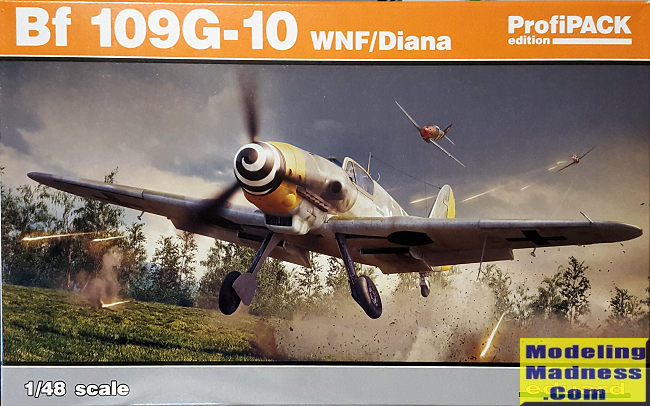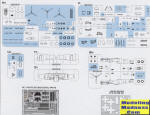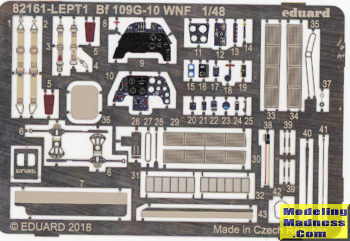
| KIT #: | 82161 |
| PRICE: | $49.99 SRP |
| DECALS: | Four options |
| REVIEWER: | Scott Van Aken |
| NOTES: | Profipack version |

| HISTORY |
Referred to as the "bastard aircraft of the Erla factory" in the Luftwaffe's Aircraft Variants Book of December 1944, the G-10 was a Bf 109 G airframe combined with the new DB 605 D-2 engine, created to maintain production levels with minimal disruption of the assembly lines until production of K-series airframes would reach sufficient levels. Despite what the designation would suggest, it appeared in service after the G-14 in November 1944, largely replacing previous G-series aircraft on the production lines of Erla, WNF and Messerschmitt Regensburg factories. Contrary to popular belief the G-10 were not rebuilt older airframes but new production. Early production G-10 may have had two data plates (usually with G-14 stamped onto it) as these airframes were originally intended to be used for G-14 assembly but were diverted to G-10 assembly.
The most recognizable external change was the use of the three-panel Erla-Haube clear-view canopy, which filled the entire canopy length behind the four-panel windscreen unit, which eliminated the older, rear fixed canopy section. Internal changes included inheriting the new 2,000 W generator and the DB 605 D-2 engine of the 109K. Apart from the standardised streamlined engine cowlings, G-10s with the DB605 D-2 were equipped as standard with the MW-50 booster system (DB 605DM, later 605DB) and had a larger Fo 987 oil cooler housed in a deeper fairing. Also, because of the engine's enlarged crankcase and the oil return lines which ran in front of it, these G-10s had small blister fairings incorporated into the lower engine cowlings, forward of and below the exhaust stacks, except for Erla-built aircraft, which had modified cowlings without the little bulges in front of the exhaust stacks. This became a distinguishing feature between Erla-built G-10s and those of other factories. The radio antenna mast was also removed from atop the rear fuselage turtledeck, and replaced with a standard late-war Luftwaffe ventral whip aerial antenna under the wing.
Approximately 2,600 G-10s were produced from October 1944 until the war's end.
| THE KIT |
 One
thing that Eduard has learned is that if it produces kits of planes that have a
long service life, they can milk it into a a bewildering number of boxings,
simply by inserting those sprues that are peculiar to whatever variant they wish
to produce at the moment. Now it is true that you cannot mix major variants (for
instance there are practically no parts in common between a 109E and the F/G),
but when it comes to the latter, you can do a lot of different boxings that use
common bits. This is evident in this kit where there are sprues with a lot of
unused parts. However, they also have to do new sprues to make up for the
subtleties between the variations.
One
thing that Eduard has learned is that if it produces kits of planes that have a
long service life, they can milk it into a a bewildering number of boxings,
simply by inserting those sprues that are peculiar to whatever variant they wish
to produce at the moment. Now it is true that you cannot mix major variants (for
instance there are practically no parts in common between a 109E and the F/G),
but when it comes to the latter, you can do a lot of different boxings that use
common bits. This is evident in this kit where there are sprues with a lot of
unused parts. However, they also have to do new sprues to make up for the
subtleties between the variations.
 So it is
with this kit. As explained in the history section, the WNF version had the
little bumps on the forward fuselage, and so does this kit. The kit also has the
wide wheel fairings which sort of limits things as not all the G-10s had the
wider wheels. The kit also has you build this with the short tail wheel. Again,
a rather limiting feature. Externally, the kit is very much like the old Revell
G-10 from the 70s. You are also supplied a taller wooden fin and tall rudder
with twin trim tabs. One of the three markings options has an antenna mast. You
are also instructed to use the canopy without the cross brace and with the
antenna mount on all four options. What this means for most is that just
grabbing a set of aftermarket G-10 decals may not be appropriate for the way
Eduard has you build this kit. True, there are bits on the sprues that you could
use to change things up, but they'd all have to be used with the wings as
supplied.
So it is
with this kit. As explained in the history section, the WNF version had the
little bumps on the forward fuselage, and so does this kit. The kit also has the
wide wheel fairings which sort of limits things as not all the G-10s had the
wider wheels. The kit also has you build this with the short tail wheel. Again,
a rather limiting feature. Externally, the kit is very much like the old Revell
G-10 from the 70s. You are also supplied a taller wooden fin and tall rudder
with twin trim tabs. One of the three markings options has an antenna mast. You
are also instructed to use the canopy without the cross brace and with the
antenna mount on all four options. What this means for most is that just
grabbing a set of aftermarket G-10 decals may not be appropriate for the way
Eduard has you build this kit. True, there are bits on the sprues that you could
use to change things up, but they'd all have to be used with the wings as
supplied.
Typical of Profipack kits, you have a color etched set to
replace a number of the standard plastic parts along with some bits that add
more detail to what is provided. A set of canopy masks that also has masks to do
the insignia of one of the markings options is also provided. For most builders,
it is this photo etch and masks that makes the Profipack kit
 boxing worth
the additional cost.
boxing worth
the additional cost.
Fortunately, this kit is light on things that are open, something that I appreciate. About the only thing you can pose open is the canopy. You can also pose the flaps and the radiator exhaust flaps up or down. The control surfaces are designed to be posed in the neutral position. The only other option is for the style of drop tank you wish to add. Note that not all G-10s carried this feature, so you need to make an early decision on carrying this item.
Instructions are excellent as always with current Eduard kits. You are provided four options. All of them are in RLM 75/83 over 76. Some of them have bits of RLM 81 on the fin and rudder with all of them having an interesting mottling on the sides. Without going into detail, I've posted an image of the options below. Note that the one without a swastika is from the so-called 'Russian Army of Liberation'. Decals are nicely done and you get a full stencil suite, though I doubt most of them were used this late in the war.

| CONCLUSIONS |
Overall, this is a very nice kit with a level of detail that is a step above the previous champion of 1/48 Bf-109s; Hasegawa. With that extra detail you pay a price and that is in ease of construction. The simple fact is that if you want more detail, you'll get more bits and therefore more effort. If you just like doing camo schemes, choose the Hasegawa kit. If you want the additional detail, then get this one.
| REFERENCES |
https://en.wikipedia.org/wiki/Messerschmitt_Bf_109_variants
January 2020 Copyright ModelingMadness.com. All rights
reserved. Got this one on sale so you don't have to pay retail if you
don't want to. If you would like your product reviewed fairly and fairly quickly, please
contact the editor
or see other details in the
Note to
Contributors. Back to the Main Page
Back to the Review
Index Page
Back to the Previews Index Page